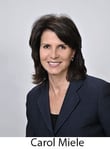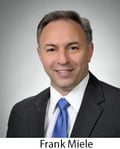by Carol G. Miele, RN and Frank Miele, MSEE
Carol Gannon Miele, RN, RVT, RDCS, FSVU and husband, Frank Miele, MSEE, lead Pegasus Lectures, Inc., an ultrasound education company specializing in digital learning. Pegasus Lectures recently released Fundamentals of Phlebology eCourse: Phase 1, designed to provide a comprehensive resource for those interested in learning about or refining the use of ultrasound in their phlebology practice. This article focuses on the origination of the course, coordination of faculty around the world, and how eLearning can enhance the scope and reach of phlebology ultrasound.

I am a firm believer in the principle that everything we do, and how we do everything, is a function of what we have learned and our past experiences. We recently undertook a large and comprehensive phlebology project fueled by what we have learned in our years of experience with digital education, what we did not know about venous studies specific to phlebology, and, unfortunately, a less than satisfying experience with medical care for a loved one.

 Several years ago, my mother experienced lower leg cellulitis which was incorrectly treated as superficial phlebitis. Pleas with the family practitioner to reconsider the diagnosis went unanswered until she presented to the ER with sepsis. The result was that an adventurous, trail-hiking, kayaking 76 year old was relegated to wearing a wound vac with over a year of visits to a wound center for hyperbaric treatments, all with the aid of a walker. This experience brought back to mind the effects of medical oversights that have altered the trajectory of my life, including an error during cardiac surgery that shortened my father’s life considerably. My point is not to lament their cases, but to focus on the fact that clearly, the education and knowledge of the practitioner can have a dramatic impact on the life of the patient and the patient’s family. We think of this fact in every project we undertake.
Several years ago, my mother experienced lower leg cellulitis which was incorrectly treated as superficial phlebitis. Pleas with the family practitioner to reconsider the diagnosis went unanswered until she presented to the ER with sepsis. The result was that an adventurous, trail-hiking, kayaking 76 year old was relegated to wearing a wound vac with over a year of visits to a wound center for hyperbaric treatments, all with the aid of a walker. This experience brought back to mind the effects of medical oversights that have altered the trajectory of my life, including an error during cardiac surgery that shortened my father’s life considerably. My point is not to lament their cases, but to focus on the fact that clearly, the education and knowledge of the practitioner can have a dramatic impact on the life of the patient and the patient’s family. We think of this fact in every project we undertake.
A few years after my mother’s treatment, while attending an ACP Phlebology panel at a Society for Vascular Ultrasound Annual Conference, I was struck by the realization that, although I have been in the field of vascular ultrasound for over 25 years and hold the RVT credential, most of the venous concepts presented were much more advanced and in-depth than what I had considered a “typical venous exam.” I also realized from conversations with others in the room that many who thought they were qualified to perform venous studies as a result of their years in vascular ultrasound, were starting to realize that there was a lot to learn about ultrasound in phlebology.
Pegasus Lectures' Origins
We began by talking with luminaries in the field. It quickly became clear that in order to provide effectual phlebology care and treatment, there is much to learn but not many formal methods to deliver this needed education.
As Alexander Pope once wrote: “A little learning is a dang’rous thing; Drink deep, or taste not the Pierian spring."
Consequently, we started to think about creating a comprehensive eCourse, building off the fundamentals of phlebology ultrasound. As we started to frame out the course, we struggled to specify the scope of the content.
This quote, in a manner, summarizes our approach to education. Education should operate on many levels so that
everyone from the beginner to the expert can find some value, as well as give a path so that there is never the danger associated with having “a little learning.”
Developing the Pegasus Learning Inc. Dream
Developing the Pegasus Lectures Inc. DreamAfter many conversations with Diana Neuhardt RVT, RPhS; Joe Zygmunt RVT, RPhS; Nick Morrison, MD; Mel Rosenblatt, MD; Catherine Burdge, APRN; Helane Fronek, MD; Stephanie Dentoni, MD; and many other luminaries, it became clear that there were two plausible paths: a shorter, less extensive, quick review-style course, or a more in-depth program that built the foundation as well as teaching the advanced content. Eventually we made decisions that would make course creation very challenging, but that would be consistent with our past education experience and our philosophy about education. We wanted to create a course that would have the breadth necessary to teach neophytes in the field, but that would still have the depth required for those with the knowledge and experience at the Fellow’s level and enhance the expertise of those already practicing in the field.
Working with the faculty during online planning meetings was much easier than anticipated. Their willingness to work after hours to bring this project to fruition made clear their dedication to furthering phlebology education; the only real challenge was coordinating time zones. After what seemed like a million meetings and even more revisions of the outline, we began working with the luminaries to create the content. At this point it became very clear that didactic lectures alone would not achieve the end result we truly desired. It was time to think outside of the box.
This outside the box thinking eventually got us to the point where one of the founding fathers of compression therapy was in his boxers on a tabletop in our hotel room, demonstrating venous pressure measurements and later being wrapped with compression bandages for demonstration – but this is getting a little too far ahead, so we will start back at the beginning of how this came to be.
Pegasus Lectures' Format
The format very quickly expanded from didactic lectures to also include:
- ScanLabs - ScanLabs are a unique method of showing completely synchronous videos of ultrasound scanning with the actual ultrasound imaging, as well as when clinically indicated, the ultrasound or fluoroscopy synchronously displayed throughout various procedures. ScanLabs allow for a unique perspective and experience of observing the best practices of industry leaders, while helping the viewer to learn new procedures and/or verify the efficacy of their current procedure techniques.
- Interactive CheckPoint Questions - Interactive questions serve as immediate feedback of comprehension of the concept currently being discussed, further emphasizing specific concepts, and keeping the viewer engaged.
- Demonstrations - The old adage is that a picture is worth a thousand words. Demonstrations of techniques and procedures much more effectively teach the concepts than a description within a lecture could ever achieve.
- Iterative Teaching Approach with Customized Review - Neuroplasticity theory and brain research has confirmed what intuitive teachers have known for years: that true, lasting learning requires an iterative approach built on strong foundational concepts as building blocks. The brain has decreasing absorption capabilities with long duration teaching. The content is broken down into modules, each detailed by time code and topic, allowing the viewer to bookmark areas of weakness for review.
- Modular Delivery - Real world obligations and family commitments limit our time and ability to further our education and exposure to new technologies. Through modular delivery, the participant is able to view on demand, according to accommodating his or her busy schedule.
Fortunately, the illustrious team of phlebology experts truly believed in the vision of a very comprehensive course. Each person was willing to expend the extra effort, often requiring long recording hours to get the lectures, demonstrations, and ScanLabs as close to perfect as possible. The process itself was very illuminating, not just about the content that we were learning as we built up the product, but also about the interaction between people who work on elite teams. At one point, I became the patient myself for one segment. I observed how the physician, sonographer, nurses, and staff approached my care and treatment as a cohesive team. I was truly impressed by the mutual respect and reliance on each team member in providing the best care possible.
Pegasus Lectures Session Videos
For the medical team itself, the process of recording also seemingly provided a significant, unexpected learning opportunity. Following the taping of a module demonstrating embolization of a sciatic vein nerve sheath malformation by Mel Rosenblatt, MD, the team members remarked on how interesting they found his commentary. “Hearing Mel explain the rationale for each step of the procedure gave me a deeper understanding of the patient’s treatment,” noted one of the staff. The thorough, step-bystep explanation put into clearer prospective the reasoning behind each step and the role each plays in the treatment of this rare and intricate procedure.
You may still be wondering: how did we get to Dr. Hugo Partsch standing on top of the table in his boxers in our hotel room? As stated earlier, everyone was willing to go the extra mile to teach difficult, often not well understood concepts through clear demonstrations. Recording luminaries from around the world certainly has its logistical challenges. On this day of recording Hugo, after lugging thousands of pounds of equipment and many hours of setup, we were ready to go in the early morning, but with no one to record. Eventually, the phone rang with Hugo’s voice on the other side sheepishly asking the room number. As it turns out, Hugo Partsch and Joe Caprini (both recording that day) had the right room number - but in the wrong hotel. Imagine the surprise of the young woman they woke from her sleep as they told her they were ready to create the video! Dr. Joseph Caprini has graciously offered his presentation on “Compression Therapy in Chronic Edema and Leg Ulcers” as a free CME module.
To access, visit PegasusLectures.com.


